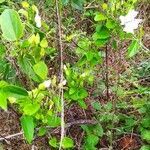Vines, herbaceous. Stems almost 4-angled to flattened, sulcate, hirsute. Petiole 0.5-4.5 cm, hirsute; leaf blade oblong-ovate to ovate to broadly ovate to oblong-lanceolate to lanceolate, 3-14 × 1.8-7 cm, both surfaces puberulent to subglabrous except for trichomes along veins or rarely glabrous, palmately 3-5-veined, base rounded to sometimes cuneate or cordate, margin entire, irregularly sinuate, or shallowly coarsely dentate, apex acute to acuminate. Flowers axillary, solitary; peduncle 1.5-5.5 cm; bracteoles ovate, 1.5-2.5 × 0.8-1.5 cm, puberulent, apex acute. Calyx 3-5 mm, unequally 10-17-dentate, glabrous. Corolla white, 3-5 cm, sparsely puberulent; tube basally cylindric for 4-7 mm, throat 1.8-2.3 cm; lobes obovate, 1.3-2.5 × 1.5-2.3 cm. Stamens included; filaments 6-10 mm, glabrous; anther thecae ca. 3 mm, divergent, glabrous. Ovary glabrous; style 1.5-2 cm, exserted; stigma funnel-shaped, ca. 2 mm. Cap-sule glabrous, basal part ca. 7 × 10-13 mm, beak 1.5-1.9 cm. Seeds 4-5 mm in diam., smooth or with scales. Fl. Aug-Jan, fr. Nov-Mar.
Herbaceous climbing or twining vine; stems strigose, subquadrangular. Leaves ovate to ovate lanceolate, 5-10 cm long, 2.0-5.5 cm wide, chartaceous, the margins undulate, hastate to cordate at the base, the tips acuminate, strigose on both the surfaces; petioles slender, 2-3 cm long. Inflorescences with the peduncle borne singly, axillary, to 5 cm; bracts deltoid ovate, 1.5-2.0 cm long, 5-8 mm wide, the tip acute attenuate, the base rounded. Flowers with the calyx with 15-20 subulate teeth; corolla white, the tube 2.0-2.5 cm long, the lobes crenate, nearly as long as the tube. Capsule depressed globose, tipped by a stout flattened, subulate beak 1.0-1.5 cm long.






